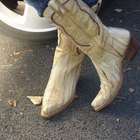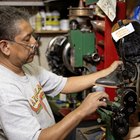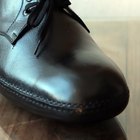The art of handmade shoes has been lost in our age of industry, and now most shoes are made and bought from factories. There are still places where you can buy handmade moccasins and boots, but most are quite costly. Making your own leather boots may be a more wallet-friendly approach.
Steps
Take measurements of the foot and calf of the person who will become the owner of the boots. Use the boot patterns to determine the dimensions of each piece of leather that will need to be cut, according to the size needed to fit the wearer.
Cut the pieces of leather needed to make the boots. Be sure to cut all needed parts. This includes the vamp, the heel, the toe boxes, the pull straps and the welt. Cut the lining pieces to match.
Stretch wet vamps over the crimp board to make the vamp pieces taut before assembling. Allow vamps to dry for a few hours.
Use all-purpose cement to attach the lining to the vamp. Attach linings to the inside of the boot tops and sew the vamps and boot tops together.
Sew the boots into the proper shape. Since rubber cement is a temporary cement, it can be used to hold the pieces in place while being stitched together.
Attach the counter and counter cover pieces to the vamp of the boot, and then attach the heel pieces to the counter and vamp of each boot.
Sew the ends of the tops together, forming tube-like structures.
Sew down a hem along the top edge of the tops, and then attach the pull straps to the inside or outside of the boot tops.
Construct toe boxes in the desired shapes, and cement and sew them to the toe end of the vamps.
Cement and sew the insoles to the constructed boots. (Make sure your insole and outsole pieces match one another and also match the pattern of the boot you are constructing. If they do not match the boot pattern, you will either end up not being able to attach them or with large creases.)
Form the steel shank to fit the arch of the wearer’s foot.
Use the all-purpose cement to attach the steel shank to the bottom of the insole, and the outsole to the bottom of the steel shank.
Sew the outsole to the insole if possible.
Apply press cement along all seams of the boots to prevent leaking. Your boots should be ready to start breaking in.
Related Articles

How to Make Snakeskin Boots

How to Make Mens Moccasin Boots

How to Fix Ripped Rubber Boots

Fixing a Boot's Heel

How to Repair and Remove the Steel Toe ...

How to Make Wader Boots

How to Make Leather Men's Shoes

How to Create Your Own Steel Toed Shoes

How to Repair a Split Rubber Sole

How Do I Shorten the Drawstrings on ...

How to Clean TEVA Sandals

How to Treat Doc Martens With Mink Oil

How to Replace Lace Grommets in Boots

How to Repair a Shoe Sole With Silicone

The Best Way to Stretch Patent Leather ...

How to Fix a Crack in My Hunter Wellies

How to Use Kiwi Mink Oil to Waterproof ...

How to Make Homemade Shoes

How to Repair Rubber Boots

How to Cut Sneaker Shields
References